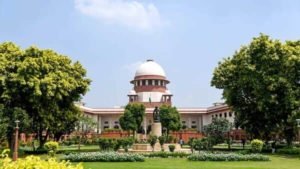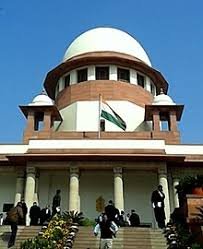Supreme Court of India judgment related to a civil appeal filed by the Municipal Corporation of Greater Mumbai against Century Textiles and Industries Limited. The core issue revolves around whether the corporation was obligated to convey a plot of land to Century Textiles after the expiration of a 28-year lease, granted under the Poorer Classes Accommodation Scheme established by earlier improvement acts. The Supreme court examined the relevant statutory provisions of the City of Bombay Improvement Act, 1898 and The Bombay Improvement Trust Transfer Act, 1925, along with the specific lease deed and board resolutions. A significant point of contention was also the considerable delay and laches in Century Textiles pursuing legal action for conveyance after the lease expired in 1955, only filing a writ petition in 2016 after a previous legal notice in 2006 did not lead to a lawsuit. The Supreme Court ultimately determined that neither the statutes nor the lease agreement mandated a conveyance, and the extensive delay in bringing the case was inexcusable, particularly given Century Textiles’s apparent intention to use the land for commercial purposes, contrary to the scheme’s social welfare objectives.
(A) Bombay Improvement Act, 1898, Section 32 – Bombay Improvement Trust Transfer Act, 1925, Section 37(2), 48(a), 51(2) – Mumbai Municipal Corporation Act, 1888, Section 527 – Expiration of lease deed – Re-Conveyance of lease land – Whether the appellant-Corporation was at all bound to convey the lease land, on completion of the terms of the lease, in favour of the Respondent No.1 free from all restrictions and liabilities or not? – Held that neither the statutory framework in force nor the terms of the lease deed imposed any obligation upon the appellant to execute a conveyance in favour of the Respondent No.1 – While the Respondent No.1 has sought to rely upon selective readings of the statutory provisions and the Board’s resolutions, a harmonious and contextual interpretation of Sections 48(a) and 51(2) of the 1925 Act, as well as the clear absence of any covenant to that effect in the lease deed, unequivocally demonstrates that no vested right to conveyance arose on the expiration of the lease – Absent any express statutory mandate or contractual stipulation, the claim for compulsory conveyance at the end of the lease term must fail.
(Para 53)
(B) Bombay Improvement Act, 1898, Section 32 – Bombay Improvement Trust Transfer Act, 1925, Section 37(2), 48(a), 51(2) – Mumbai Municipal Corporation Act, 1888, Section 527 – Expiration of lease deed – Re-Conveyance of lease land – Respondent No.1 failed to take any active step in furtherance of getting such a conveyance executed at the end of the lease term – A major reliance has been placed by the Respondent No.1 on Section 51(2) of the 1925 Act, which clearly states that the Board shall convey the premises to the lessee at his cost – The term “at his cost” shall include the charges involved in conversion of lease hold property into free hold property and would routinely comprise of registration charges, stamping charges etc. – Respondent No.1, after the expiry of term of the lease, has neither paid any such charges towards the cost in an effort to seek conveyance nor availed any alternative remedy by filing a suit for specific performance or mandatory injunction – Therefore, the Respondent No.1’s reliance on Section 51(2) will also not come to their rescue when it is apparent that they have not fulfilled their part of the obligation under the said provision – Appellants were neither bound nor were under any legal obligations to convey the premises comprising Block-A to the Respondent No.1.
(Para 54 and 55)
(C) Constitution of India, Article 226 – Bombay Improvement Act, 1898, Section 32 – Bombay Improvement Trust Transfer Act, 1925, Section 37(2), 48(a), 51(2) – Mumbai Municipal Corporation Act, 1888, Section 527 – Conveyance of lease land – Writ jurisdiction – Delay and laches – Admittedly, the term of the lease came to an end on 31.03.1955 – It is also uncontested that thereafter the Respondent No.1 never claimed execution of conveyance at any point of time till 2006, when for the first time they issued a legal notice dated 14.08.2006 purported to be under Section 527 of the 1888 Act requiring the appellant to execute the conveyance deed – Thus, for a period of 51 years, the Respondent No.1 did not raise any demand whatsoever for execution of the conveyance deed – Their contention that they were in constant communication with the officers of the Corporation, though orally, the fact remains that no legal proceedings were undertaken during this period – Even after giving the notice under Section 527 of 1888 Act, the Respondent No.1 took no steps for a period of 10 years by filing a suit or approaching the Court even though the period of limitation prescribed under the above provision was six months – Ten years after the legal notice, they preferred the writ petition, i.e. after 61 years of the cause of action having arisen –High Court held that there was inaction on the part of the appellant in not executing the conveyance deed – On the contrary, Respondent No.1 never approached the appellant requiring them either to provide the details of the stamp duty, registration charges etc. so that the conveyance deed could be typed out on such stamp papers and thereafter to be presented for registration – The Respondent No.1 has neither made any pleadings nor has led any evidence to the above effect – The view taken by the High Court in treating the petition to be not suffering from any delay and laches cannot be sustained.
(Para 56 to 58)
(D) Constitution of India, Article 226 – Mumbai Municipal Corporation Act, 1888, Section 527 – Bombay Improvement Trust Transfer Act, 1925, Section 37(2), 48(a), 51(2) – Writ jurisdiction – Alternative remedy – Limitation – Respondent No.1 had a statutory remedy of filing a suit under Section 527 of the 1988 Act which they could have availed – In fact, the Respondent No.1 proceeded in that direction by giving a notice to file a suit but never filed the suit although limitation for the same was six month – Held that the Respondent No.1 apparently chose to file the writ petition in 2016 after 10 years only in order to escape from the clutches of the limitation
(Para 63)
(E) Bombay Improvement Trust Transfer Act, 1925, Section 37(2), 48(a), 51(2) – Lease Deed – Altering use of plot from residential to commercial – Respondent No.1 had submitted plans in 2009 for altering the use of Plot A for commercial purposes and would no longer be providing for Poorer Classes Accommodation as was agreed in the lease deed of 1928 – Clause 2(VIII) of the lease deed explicitly states the purpose of the lease deed – While the Respondent No.1 would have been allowed to use it for commercial purposes had the land been duly conveyed to them, but conveyance was never granted in the sale deed dated 1928, nor was any “cost” paid for the conveyance – The lease deed, by itself, did not confer any rights to convert the usage of the lands for commercial purposes – The 1925 Act was clearly intended to secure broader societal goals—better sanitation, improved living standards, and well-planned urban growth that includes and benefits marginalized communities – Allowing Respondent No.1 to disregard these obligations would open the door to hollowing out the protections and advantages established by the statute – It would set a precedent where statutory schemes designed to uplift vulnerable groups could be co-opted for purely commercial ends, undermining the trust and faith that must exist between public authorities, private actors, and the most vulnerable segments of the population- In essence, the entire arrangement is anchored on a quid pro quo: the property is leased on special terms, with minimal rent and under carefully prescribed conditions, to ensure that the less-privileged receive tangible benefits – When the lessee attempts to convert this arrangement into a vehicle for commercial gain, it repudiates the fundamental bargain – The public trust reposed in the private entity to serve a greater good is thus betrayed – This not only harms the class of beneficiaries whom the legislation and agreement were designed to protect, but also imperils the broader public interest by allowing beneficial legislative frameworks to be distorted and exploited contrary to their genuine purpose – Judgment of the High Court cannot be sustained liable to be set aside, and the writ petition dismissed.
(Para 64, 65, 68 to 70)
(F) Interpretation of statute – Harmonious construction – Well-settled principles of statutory interpretation demand that no provision of a statute should be rendered nugatory or superfluous. A statute must be construed as a coherent whole, ensuring that each part has meaningful content and that the legislative scheme remains workable. Where two provisions appear to be in tension, the proper course is to adopt a construction that reconciles them, allowing both to operate and giving effect to the underlying legislative intent.
(Para 48)
The Municipal Corporation Of Greater V, Century Textiles And Industries
Supreme Court: 2025 INSC 36: (DoJ 07-01-2025)








